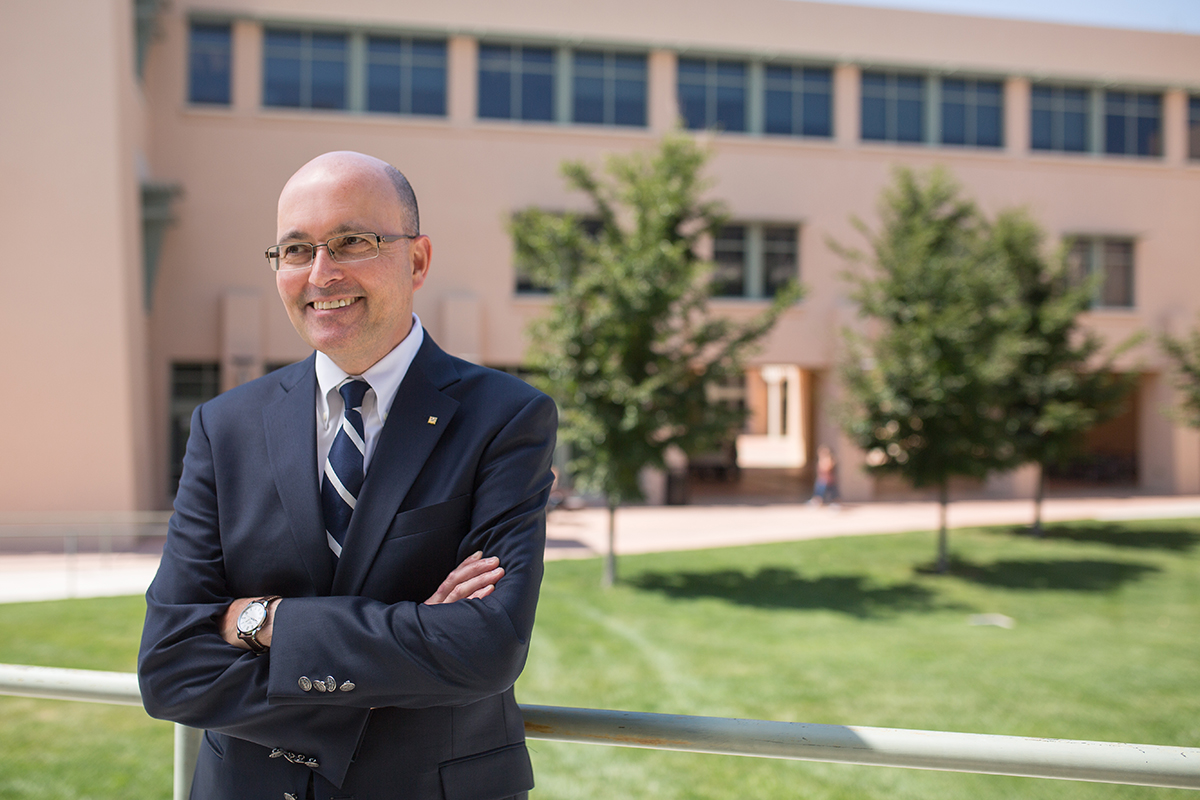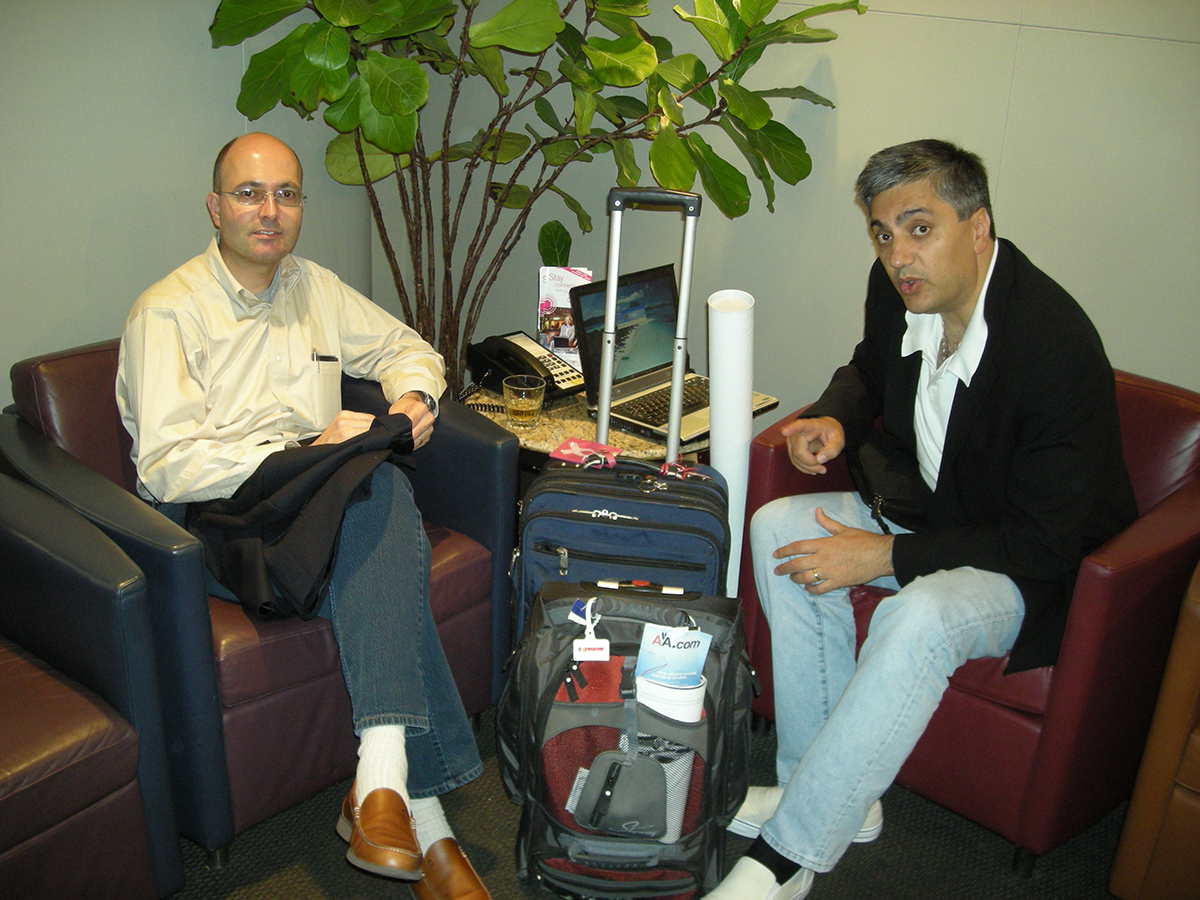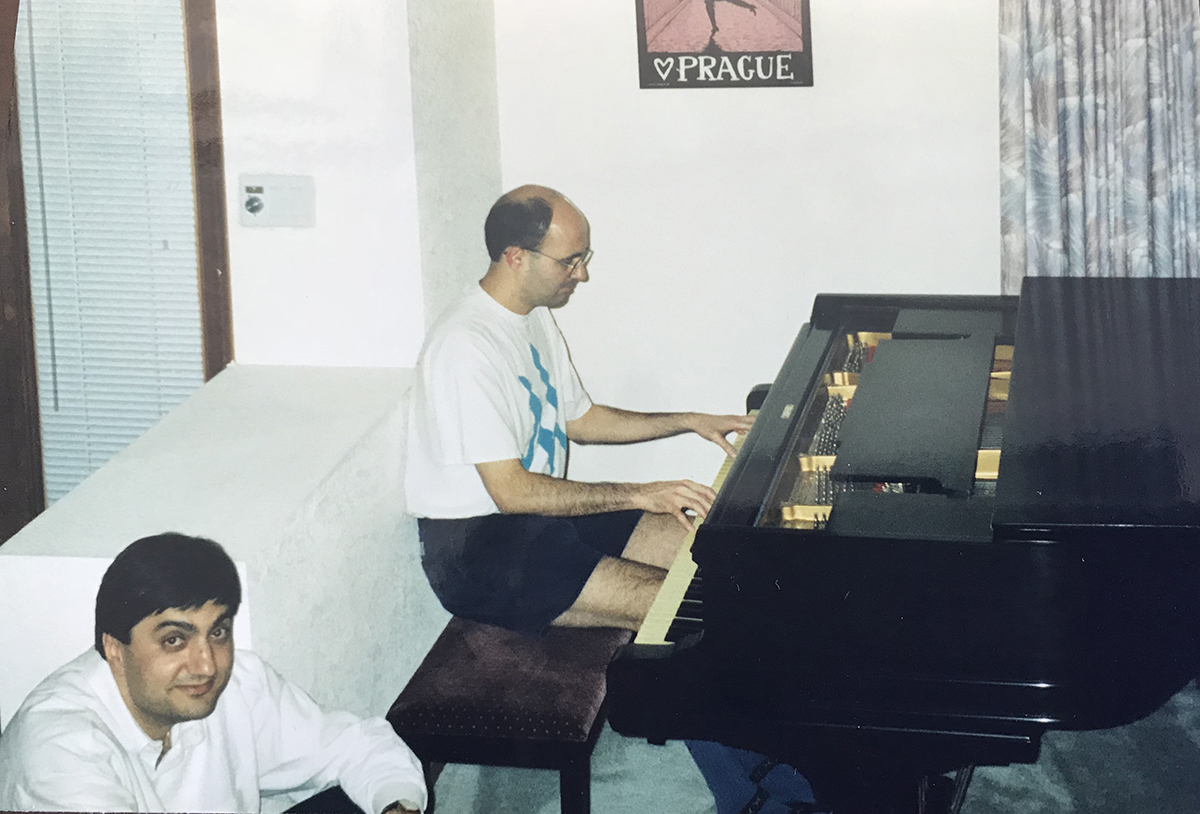Recent News
UNM Engineering team wins ASEE best paper for work on first-year engineering course
July 17, 2025
New director will enhance interdisciplinary engineering learning opportunities
July 2, 2025
Final SIRI cohort visits UNM campus
June 30, 2025
Perfetti receives ANS Landis Engineering Achievement Award
June 26, 2025
News Archives
66 semesters on Route 66 and still going strong
October 26, 2020 - by Kim Delker
Edl Schamiloglu looks back on three decades as a faculty member at UNM, and the journey that brought him here

As a child growing up in a tenement in the Bronx in the shadows of Yankee Stadium, Edl Schamiloglu probably never could have imagined that he would one day make his home among the mountains, prickly pears, and cholla in the high desert of the Southwest.
But since 1988, that is exactly where he has been, as a distinguished professor in the Department of Electrical and Computer Engineering at The University of New Mexico. He also is associate dean for research and innovation in the School of Engineering, and the special assistant to the provost for national laboratory relations.
Even though becoming a professor in Albuquerque, New Mexico, was not his original intention (more on that later), he’s found a niche for over three decades at UNM and shows no signs of slowing down.
Schamiloglu recounted his journey in academia in a graduate seminar at the beginning of the semester titled “66 Semesters of High Power Microwave Research on Route 66.” (And being the detail-oriented engineer that he is, he pointed out that it’s actually more than 66 semesters — 99 semesters if you count summer terms.)
Long journey to America
His family’s journey stretches back to the former Soviet Union, where his father, Muhamed (born Zufer Akhtyamov), was born in a region called Tatarstan in 1916. Labeled a son of a “kulak,” his father was kicked out of school in fifth grade and remained a virile anti-communist. Schamiloglu’s “strange name,” as he called it, has an unusual origin. His first name, Edl, is derived from “Edil,” which is the Tatar name for the Volga River that runs through Russia (also, “Idil” in Turkish and “Idel” in Tatar).
His equally-rare last name, which has elements of both Turkish and German, also has an unusual origin, which follows the journey of his father, who was leftover in Germany after being a World War II prisoner of war. He was in the Soviet Red Army in the war, surviving the 900-day siege of Leningrad. He was captured in Stalag 17, escaped, and manufactured the Schamiloglu name so he wouldn’t seem Soviet, then he was let go.
However, that made Muhamed stateless after the war. He wanted to go to Turkey but was stuck in Germany and Austria. It was Church World Services that sponsored his first journey to the U.S. in 1950. But he was in for a rude awakening. When he got off the ship on Ellis Island, they informed Muhamed that since he was Tatar, which was considered Oriental (Asian), which was a Soviet country in the midst of the Cold War and Red Scare in the U.S., he had to go back because the quota for emigrants from Asia had been met. He had better luck the second try (the Immigration and Nationality Act of 1952 would eliminate the quota system), settling in the Bronx and immediately finding work as a night-shift janitor.
Meanwhile, Schamiloglu’s mother, Faile, was on another journey. She was born in Russia in the city of Blagoveshchensk on the border with China along the Amur River in 1922 as her father (a fur trader) was escaping the communists and took the family and left the Tatar region of Russia in the west to seek refuge in China. She was educated in a Catholic missionary in the city of Harbin, but she contracted diphtheria in middle school, putting an end to her formal education. She left Russia and came through China, which was ruled by Mao Zedong, then fled to Hong Kong and ended up in Istanbul as refugees in 1955, where she met Edl’s father, who was visiting there. They married in 1957, and eventually, she was granted a visa to come to the U.S. in 1958. Schamiloglu’s father became a U.S. citizen in 1957, and his mother a citizen a few years later. His older brother, Uli, was born that year, and Edl was born the next year.

Schamiloglu (center, with daughter Selin), Chaouki Abdallah (left), and former UNM professor and associate provost Greg Heileman have a Big 4-0 celebration.
Bronx born and raised
The Schamiloglus settled in the Bronx, where Muhamed worked as a maintenance mechanic at the next-door hospital for the majority of the boys’ childhoods, and Edl’s mother worked as a nurse’s aide. They lived a comfortable middle-class life, sending both children to college, even though the parents had few skills and no education. “You can’t do that today,” Schamiloglu said.
Both sons showed an early aptitude for technical subjects, but Uli ended up taking a different turn, becoming a history professor specializing in Tatar history and Turkic languages. He is a professor emeritus from the University of Wisconsin and is currently in the Department of Kazakh Language and Turkic Studies at Nazarbayev University in Nursultan, Kazakhstan.
In addition to being good in math and science, Edl was also gifted in violin and piano (the latter of which he still plays to this day). Going to school in the Bronx in the 1970s meant dealing with a lot of violence, heroin needles littering the streets, and gangs. When it came time for high school, instead of attending nearby Taft High School, he had a choice: either a school for the performing arts or the Bronx High School of Science, a public charter school in a nicer area of the city.
Schamiloglu said he was accepted to performing arts school, and only barely made it into Bronx School (which was admitted by exam). He opted for the technical track because of a logical conclusion: “I figured I could make a good living as an engineer and do piano on the side, but a career in music might not provide me a good living and it would be hard to do engineering on the side.”
At the Bronx High School of Science, he was among like-minded students (he said the high school has produced more Nobel Laureates than any other secondary school in the U.S.) who were serious about school and going to college. His classmates included astrophysicist Neil DeGrasse Tyson and George Yancopoulos, co-founder and chief scientific officer of Regeneron Pharmaceuticals, which is now in the news for the COVID-19 antibody treatment that President Trump received and research on a vaccine.
“Going to Bronx High School was like a country club,” he said. “I didn’t fear for my life anymore.”
A future in fusion?

Around this time, Schamiloglu read an article in Popular Science about fusion science and was captivated. The oil crisis of the 1970s was raging, and many people were starting to seriously consider alternate energy sources. He knew then he wanted to pursue studies in fusion plasma physics.
After high school, Schamiloglu attended Columbia University. He was accepted at other schools, like Rensselaer Polytechnic Institute and Brooklyn Polytechnic on full scholarships, but he always had his heart set on Columbia. Also, his mother was a member of the AFL-CIO Local 144, which offered a scholarship to Columbia. He received it (as his brother did the year before), and his choice was made.
Although he managed to graduate in three years, he was “shocked at how hard college was.” His first term, he was making an A+ in English but struggled in the technical subjects, pulling D’s. But he quickly turned that around and took summer courses in various subjects like Russian and working in a plasma lab. He earned his bachelor’s degree in applied physics in 1979, then decided to stay at Columbia for a master’s degree, which he earned in 1981. He stayed at home during his Columbia years, leaving for Cornell for his Ph.D. studies.
“Cornell was like leaving home to go to college for me,” he said. “I really learned what it meant to do research.”
Although he was always good at technical subjects, he said his success is largely due to something else.
“A lot of people are smarter than me in math and science, but I think what has set me apart is my writing skills and making connections between disparate things,” he said.
He earned his Ph.D. in six-and-a-half years, then planned to take his ion ring experiment he had been working as a graduate student to Los Alamos National Laboratory, where he had secured a postdoctoral research position. However, the politics of the time interfered with his plans.
In May 1987, President Reagan’s Department of Energy announced an end to funding alternative concept fusion concepts, investing only in Tokamaks for magnetic fusion, eliminating funding for the Los Alamos group, as well as the funding for the postdoc. A Plan B was needed and came soon thereafter.
In August 1987, Stan Humphries, a UNM professor, moved from the Department of Chemical and Biological Engineering to the Department of Electrical and Computer Engineering and was needing to hire an assistant professor. Schamiloglu flew out for an interview with his wife, and she didn’t like what she saw of Albuquerque. He told her, “Don’t worry, you’re not going to move here.” However, there were not a lot of academic career options at the time in fusion plasma physics, so when he got an offer for a faculty position, he accepted. He was hired in January 1988 (and his wife soon warmed up to Albuquerque).
Even though professors often skip around from institution to institution, Schamiloglu said that the nature of his work makes that a little more difficult, so that’s been a factor in keeping him at UNM. “I have a physical lab with a lot of equipment, which is not easy to move,” he said.
Hitting his stride at UNM

Schamiloglu and Chaouki Abdallah on a business trip
He has been a principal investigator on over $50 million worth of contracts and grants at UNM and has received numerous citations and awards for his research through the years. He’s also advised around 60 master’s and Ph.D. students and continues to teach while maintaining a very large research load.
“I think it’s important to continue teaching. I still learn something,” he said. “It’s always good to have students ask questions.”
At this stage of his career, he’s able to delegate a lot of research to his graduate students, guiding and directing as needed.
“A conductor of symphony is what I do,” he said.
He said the greatest reward of his career are the times when he has been recognized by his peers, such as when he has been elected as Fellow of the IEEE and most recently as a Fellow of the American Physical Society.
“It’s hard to build a reputation, but to destroy it is easy, so earning the respect of my peers ranks very high,” he said.
He has been married to Elmira since 1983. They met in 1981 while he was visiting her native country of Turkey, and the couple corresponded frequently through letters until their marriage. Their daughter, Selin, is a Ph.D. student in neuroscience at the University of California, San Francisco, who is planning to follow in her father’s footsteps in academia. (She is also a Columbia University graduate like her father and uncle.)
The Schamiloglu family in America is a testament to the transformational power of higher education and all that is possible with a lot of hard work and persistence. Although his parents were not educated, they understood the importance of education and encouraged their children to pursue it.
“I think it is very common in immigrant families,” he said. “My father didn’t even know what college was or what a Ph.D. was, but he knew that getting an education was paramount.”
From his parents, he learned the importance of dedication and perseverance.
“It’s important to have persistent, consistent effort,” he said, even admitting that he doesn’t have a work-life balance. It all flows together as one — work and travel. In normal times, Schamiloglu can be found traveling to conferences and technical meetings around the globe. He’s traveled to dozens of countries and every continent except for Antarctica.
“I honestly don’t view it as a job,” he said.
When he does take breaks, he enjoys cooking, wine, hiking, reading, and playing the piano.
Even though he’s been in the job for three decades, Schamiloglu isn’t even thinking about retiring.
“Some faculty hang on too long, so there’s a balance, but I’m at the peak of funding, and I can easily see myself continuing for many more years,” he said.

Schamiloglu engages in his chief pastime while Abdallah listens.
